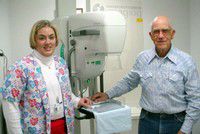New mammogram machine detects breast cancer sooner
Published 4:00 pm Wednesday, October 30, 2002

- Radiology Technician Missi Hayward and Wallowa Valley Health Care Foundation board member Reid Johnson show off Wallowa Memorial Hospital's new mammogram machine that is expected to be paid off after the upcoming foundation fundraising dinner and auction. Photo by Elane Dickenson
Wallowa Memorial Hospital’s Instrumentarium Imaging mammogram machine has been “busy every day most all day” since it arrived this summer, said Radiology Technologist Missi Hayward when she proudly showed off the new piece of equipment last week.
October is Breast Cancer Awareness Month, and the machine is on the front line of the battle against breast cancer in Wallowa County.
Trending
The equipment will also be the beneficiary of the annual Healthy Futures dinner and auction to be hosted on Nov. 9 by the Wallowa Valley Healthy Care Foundation. The event is expected to pay a substantial chunk of the $67,000 price tag, since the foundation dinner, which is already sold out, traditionally raises $30-35,000. Two other donations, $20,000 from former county residents Richard and Mary Frasch and $5,000 from Marion Indihar, an R.N. in the Wallowa Valley Care Center, have also been received for the unit.
Though the last mammogram machine was only about four years old, it was already obsolete.
“Every few years they change the radiation standards, and the old one exceeded the new standards,” explained Larry Davy, WMH administrator. He said that though the new standards didn’t go into effect until this fall, when part of the old machine broke down this summer, the decision was make to buy a new one early. “I was able to negotiate a really good deal,” said Davy. The Wallowa County Health Care District took out a loan to take advantage of the deal, and that loan will soon be retired thanks to the foundation and the other generous donors.
Davy said that in addition to the lower radiation level, the new equipment has a number of other benefits. It is able to scan more tissue and multidirectional compression is designed to make the process more comfortable because the pressure is more spread out. “Maybe the ladies can speak on that,” said Davy. “I know a lady physician was very involved in the way it works, looking at it from a woman’s perspective.”
Despite the contradictions of studies concerning the use of mammography and long-term survival rates, Davy said that mammograms are “still the gold standard” in breast cancer detection. “We’ve talked about this in depth,” he said, adding that he personally doesn’t believe the conclusions of a study that casts doubts on long-term survival benefits. “I don’t believe it myself. Mammograms find cancers before you or your doctor can find them. … Anyone close to health care can tell lots of stories about their benefits.”
Radiology technician Hayward also has no doubt that mammograms save lives, and is especially pleased with the new machine which produces a much better quality of film.
Trending
“We love it,” she said. “In a recent case, a women in her late 30s or early 40s came in, and we found a very small tumor. It was too small to feel and we would not have caught it on our old machine.”
She explained that a filter allows adjustments for different density of breasts. “It makes a lot of difference,” she said. She also agreed that the new machine is less painful for most women.
The equipment now shares a room with another recent addition, a new CT machine, which slows down its use somewhat. However, the mammography equipment will eventually have its own room, the old X-ray room. In addition to Hayward, Stephanie Gassett and Sharon Cramer operate the mammography equipment.
Though the Healthy Futures dinner is sold out, the public is invited to place bids for an impressive lineup of donated items and service in both the silent and oral auctions the evening of Nov. 9, to help pay for the hospital’s new mammogram machine.









